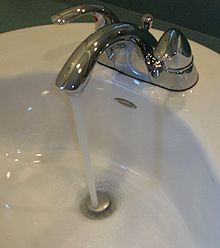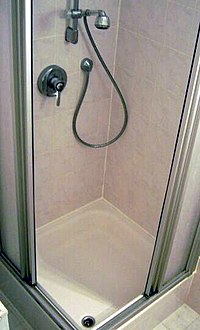Water Taps
 |
| Basic Water Valve or Silcock |
Water for baths, goes under and basins can be provided by distinct hot and cold valves; this arrangement is widespread in older installations, especially in public washrooms/lavatories and utility rooms/laundries. In kitchens and bathrooms mixer valves are commonly used. In this case, warm and cold water from the two valves is blended before reaching the outlet, allowing the water to emerge at any warmth between that of the warm and cold water supplies. Mixer valves were created by Thomas Campbell in 1880.
North American shower tap. Lower lever controls water go out; right: to wash ("SHR"), left: to bathtub ("TUB"), middle: no water. Center lever temperature controls: turn counter clockwise to augment water flow, turn further to increase warmth.
 |
| Plastic Tap |
 |
| Dual Taps, this are use commonly in hotels and condominium as well as in resorts. |
If distinct taps are fitted, it may not be immediately clear which tap is warm and which is freezing. The warm tap generally has a red sign while the cold tap generally has an azure or green indicator. In the joined States, the taps are often furthermore marked with an "H" or "C". Note that in nations with Romance dialects, the notes "C" for hot and "F" for cold are utilized (from French "chaud"/Italian "caldo" (hot) and French "froid"/Italian "freddo" (cold)). This can conceive disarray when English speakers visit these countries or vice versa. Mixer valves may have a red-blue stripe or arrows showing which edge will give warm and which freezing.
Warm is on the left in numerous nations.
In most nations, there is a benchmark placement of hot/cold valves. For demonstration, in the joined States and many other countries, the warm tap is on the left by construction cipher obligations. Many installations exist where this benchmark has been disregarded (called "crossed connections" by plumbers). Mis-assembly of some single-valve mixer valves will exchange hot and freezing even if the fixture has been plumbed rightly.
Most manages on residential homes are connected to the valve shaft and fastened down with attach. Although on most commercial and industrial submissions they are fitted with a removable key called a "loose key", "water key", or "sillcock key", which has a rectangle peg and a rectangle completed key to turn off and on the water; the "loose key" can be removed to avert vandals from rotating on the water.[citation needed] In older structures before the "loose key" was invented it was common for some landlords or caretakers to take off the handle of a residential tap, which had teeth that would rendezvous up with the gears on the valve shaft. This Teeth and cog system is still utilized on most up to date toilets. Whereas most of the time a "loose key" is on developed and commercial submissions, they may also be discovered at dwellings by the shoreline to avert passers-by from cleaning the sand off their feet.
Tap Mechanisms
 |
| How Tap Works |
Gate valves use a steel computer disc the identical diameter as the pipe which is attached into location perpendicularly to the flow, chopping it off. There is no resistance to flow when the tap is completely open, but this type of tap rarely donates a perfect close when shut. In the UK this kind of tap commonly has a wheel-shaped handle rather than a crutch or capstan handle.
Cone valves or ball valves are another alternate. These are routinely discovered as the service shut-off valves in more-expensive water systems and generally found in gas valves (and, accidentally, the cask beer valves referred to above). They can be recognized by their variety of motion—only 90°—between completely on and completely off. Generally, when the handle is in line with the pipe the valve is on, and when the handle is over the pipe it is closed. A cone valve comprises of a shallowly-tapering cone in a tight-fitting socket placed over the flow of the fluid. In UK English this is usually renowned as a taper-plug cock. A ball valve benefits a spherical ball rather than. In either case, a hole through the cone or ball allows the fluid to pass if it is bordered up with the openings in the socket through which the fluid enters and departs; rotating the cone using the handle rotates the route away, giving the fluid with the unbroken exterior of the cone through which it cannot overtake. Valves of this kind using a cylinder rather than a cone are sometimes encountered, but utilizing a cone permits a taut fit to be made even with moderate constructing tolerances. The ball in ball valves rotates inside artificial seats.
Hands free infrared proximity sensors are restoring the benchmark valve. Thermostatically controlled electrical devices dual-purpose mixing or diverting valves are utilized inside industrial submissions to automatically provide liquids as needed.
Base controlled valves are established inside laboratory and healthcare/hospitals.
Up to date valves often have aerators at the tilt to help save water and decrease splashes. Without an aerator, water generally flows out of the tap in one large-scale stream. An aerator spreads the water flow into many little droplets.
Modern bathing room and kitchen valves often use ceramic or artificial surfaces skidding against other spring-loaded ceramic exterior or artificial washers. These are inclined to require far less maintenance than customary globe valves and when upkeep is required, the whole central of the valve is generally restored, often as a lone pre-assembled cartridge.
Of the trio of well-respected toilet manufacturers in North American plumbing rounds, Moen and American benchmark use cartridges (Moen's being O-ring founded, American Standard's being ceramic), while Delta benefits easily-replaced rubber chairs facing the cartridge(s). Each conceive has its benefits: Moen cartridges tend to be easiest to find, American benchmark cartridges have nearly infinite lifespan in sediment-free municipal water, and Delta's rubber seats are inclined to be most forgiving of sediment in well water.

